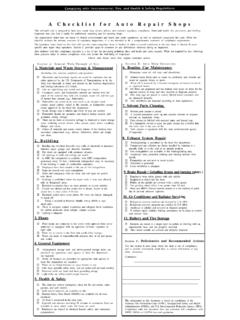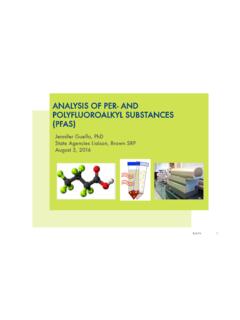Transcription of 2. Characterization: Sampling and Testing …
1 41 This brochure is the second of five in a guidance series to help applicants work through Sampling of polychlorinated biphenyl (PCB) remediation waste at Brownfields projects. The Toxic Substances Control Act (TSCA) and the federal PCB regulations under 40 (CFR) Part 761 govern the manufacture, use, distribution in commerce, storage, and disposal of brochure focuses on characterization and verification of PCB remediation waste sub-ject to TSCA. Remediation waste is defined in Brochure 1. There are three options for the type of cleanup performed: self-implementing, risk based, and performance based. See Brochure 3 of these series for more information. The majority of the information in this brochure pertains to the self-implementing requirements specified under the self implementing cleanup and disposal option should be considered as a starting point when designing Sampling programs under the risk or performance-based disposal option.
2 The self implementing option is very prescriptive and can be very costly to implement at large sites. The risk based option can provide more flexibility and may lead to significant project cost savings. characterization Sampling assesses the nature and extent of PCB impacted materials and is described in Subpart N (40 CFR ) Verification Sampling of PCBs is performed after remediation to assess achievement of remediation regulations may affect characterization and remediation objectives and should always be considered when developing a Sampling plan. Brochure 5 provides state-specific infor-mation. PCB remediation waste characterization Sampling must be based on as-found conditions ( , in place before any disturbance) rather than collected from stockpiles or roll-off con-tainers generated during excavation or demolition are four classes of PCB remediation waste, discussed in the table below, that are sampled and tested differently during characterization and verification: bulk remediation waste, porous materials, non-porous materials, and liquid remediation waste.
3 Extraction holding times must be considered and should be kept below 14 days if possible. Samples can be frozen to extend the holding time. The use of field screening data is limited. The data can assist with field decisions but cannot be used to meet the characterization and verification Sampling requirements in these regulations. The accuracy and precision of any field screening should be demonstrated through laboratory data and field instrument calibration. Field screening can assess, on a preliminary basis, if PCB removal is complete or to fill in data for a risk-based ap-proved Sampling grid. Laboratory data must be used to provide final documentation that a PCB cleanup and disposal has been completed. All analytical data must be retained by the responsible party for a minimum of 3 Website: following documents are available at the EPA website: Code of Federal Regulations Part 761 The Polychlorinated Biphenyl (PCB) Site Revitalization Guidance, November 2005.
4 PCB Questions and Answers Manual, Updated January 2009. EPA Region 1 - Standard Operating Procedures for Sampling Porous Surfaces for Polychloriated Biphenyls (PCBs), Revision 4, May 5, 2011. Sampling Guidance for 40 CFR 761 Subparts M, O, P, and RCharacterization of Remediation Waste A Conceptual Site Model (CSM) is the initial step in developing a Sampling plan for characterization . This model should identify all possible sources of PCBs, their release mechanisms, and classes of remediation waste potentially impacted. Sample location, sample depth, collection method, and Sampling density will be based on this Remediation Waste ClassificationExamplesCharacterization Regulatory ReferenceVerification Regulatory ReferenceBulk Remediation WasteExisting piles of soil, in-situ soil, sediments, sludge40 CFR (a)(2) and (a)((5)(i)(B)(2)(i); and, 40 CFR CFR (a)(6) and Subpart O (40 CFR ).)
5 Porous surfacesUnpainted or painted structural surfaces made of concrete, brick, wood, plaster, plasterboardNon-porous surfacesSmooth unpainted solid surfaces that limit penetration of liquid containing PCBs beyond the immediate surface ( smooth un-corroded metal, smooth glass, high-density plas-tics, impermeable building stone such as marble or granite).40 CFR CFR (a)(6) and Subpart P (40 CFR ).Liquid PCB wasteHomogenous flowable material containing PCBs and no more than 0 .5 percent by weight non-dissolved material ( hydraulic oil and dielectric fluid).40 CFR 26940 CFR (a)(6) and 40 CFR Requirements by PCB Remediation Classification TypeBrochure SeriesGuiding States and Brown-field Projects through the PCB Rules under TSCA: Navigating the TSCA process is complex and represents a challenge for many Brownfield remedia-tion and redevelopment projects which can stretch limited funds.
6 This bro-chure series focuses on the topics most relevant to the states and their Brownfield stakeholders:1. Working with the Fed-eral and State PCB Regula-tions on Brownfield Sites: When and What Federal Involvement is Required;2. characterization : Sampling and Testing Ap-proaches for PCBs; 3. Cleanup and Manage-ment of PCBs;4. PCBs in Building Materi-als; and5. PCB Articles, Containers and guidance document addresses cleanup and disposal requirements for Polychlorinated Biphenyls (PCBs) only. This guidance document does not replace or supplant the requirements of the Toxic Sub-stances Control Act (TSCA) PCB regulations. Please refer to the PCB regulations at 40 CFR Part 761 for specific regulatory and legal Region 1 Contact InformationKim Tisa (Regional PCB Coordinator) phone: 617-918-1527 Marianne Milette (Enforcement) phone: 617-918-1854 TSCA Hotline - 202-554-1404 or e-mail State Contact Information, please see Brochure #5 - PCB Articles, Containers and Liquids2.
7 characterization : Sampling and Testing Approaches for PCBsThis brochure was prepared by the New Jersey Institute of Technology with funding provided by a cooperative agreement with established Sampling procedures for site characterization which are found in 40 CFR 761, Subpart N. Bulk remediation waste and porous surfaces (40 CFR ) In-situ soils and porous materials should be sampled on a horizontal grid interval of 3 meters (10 feet). Unlike horizontal Sampling , vertical Sampling of a surficial release is not as prescriptive. It is an iterative Sampling process until the uppermost clean interval from surface can be demonstrated. Multiple samples may need to be collected at the intervals you select, based on the results of the prior sampled interval, until the first clean inter-val is reached.
8 Alternatively, to minimize Sampling and analytical costs, you could analyze only the sample from the shallow and deep intervals. If the deep interval is clean, assume the soil is contaminated from the surface to the depth of the deeper sample analyzed. If the deep interval is not clean, additional Sampling is required. Collect a minimum of three samples for each type of remediation waste or porous surface even if waste is present at the site in a small amount. There is no upper limit to the number of samples to be collected. If PCB impacted soils are in contact with groundwater, then a groundwater sample should be collected and analyzed for PCBs. Bulk-remediation soils found in containers ( drums or roll-off containers) should be characterized us-ing one core sample per container if three or less containers are on site.
9 For more than three containers, 10 percent of all containers, or three samples, whichever is larger should be sampled. This applies to bulk remediation waste containerized before you begin working at the site and therefore has unknown origin, since bulk remediation waste should always be sampled in place. Non-Porous surfaces (40 CFR ) Sample large, nearly flat, non-porous surfaces by dividing the surface into rough square portions approxi-mately 2 meters on each side. Standard wipe tests as defined in 40 CFR should be performed. It is not necessary to sample small or irregularly shaped surfaces. Liquid remediation waste (40 CFR ) Collect one sample for each phase of the liquid; only one sample is required for a single phase liquid.
10 There are no specified procedures for collecting a sample under 40 CFR ; however, adherence to accept-able Sampling procedures is recommended. If a liquid contains a non-liquid phase (greater than percent by total weight) the non-liquid waste should be separated and sampled as a bulk remediation waste ( sludge).Verification of Cleanup Bulk remediation waste and porous surfaces (Subpart O) Collect a minimum of 3 samples per each type of remediation waste. Use a square-based grid system to overlie the entire area to be sampled. Orient the grid axes north to south. Mark out a series of Sampling points meters (5 feet) apart. The area of inference provides the area characterized by each sample result (see Figure 1).






